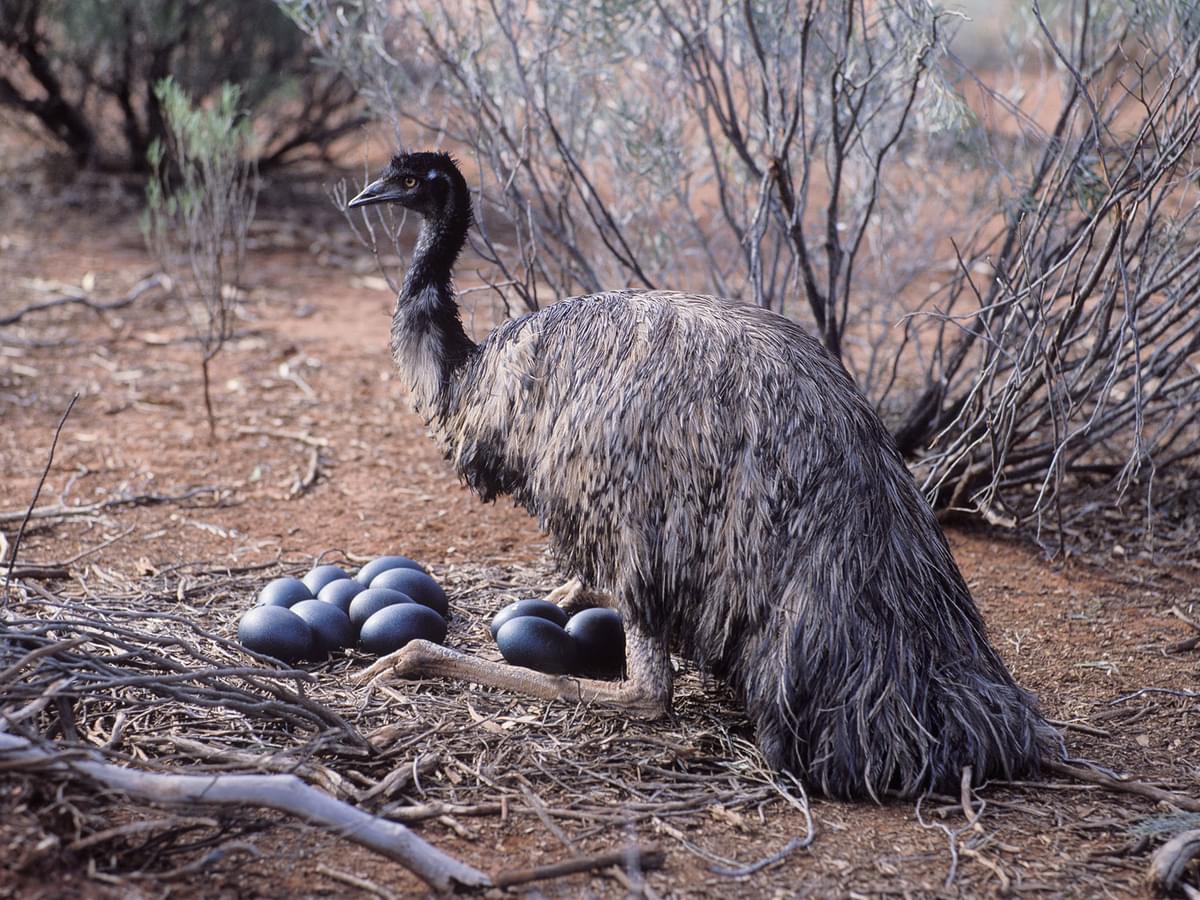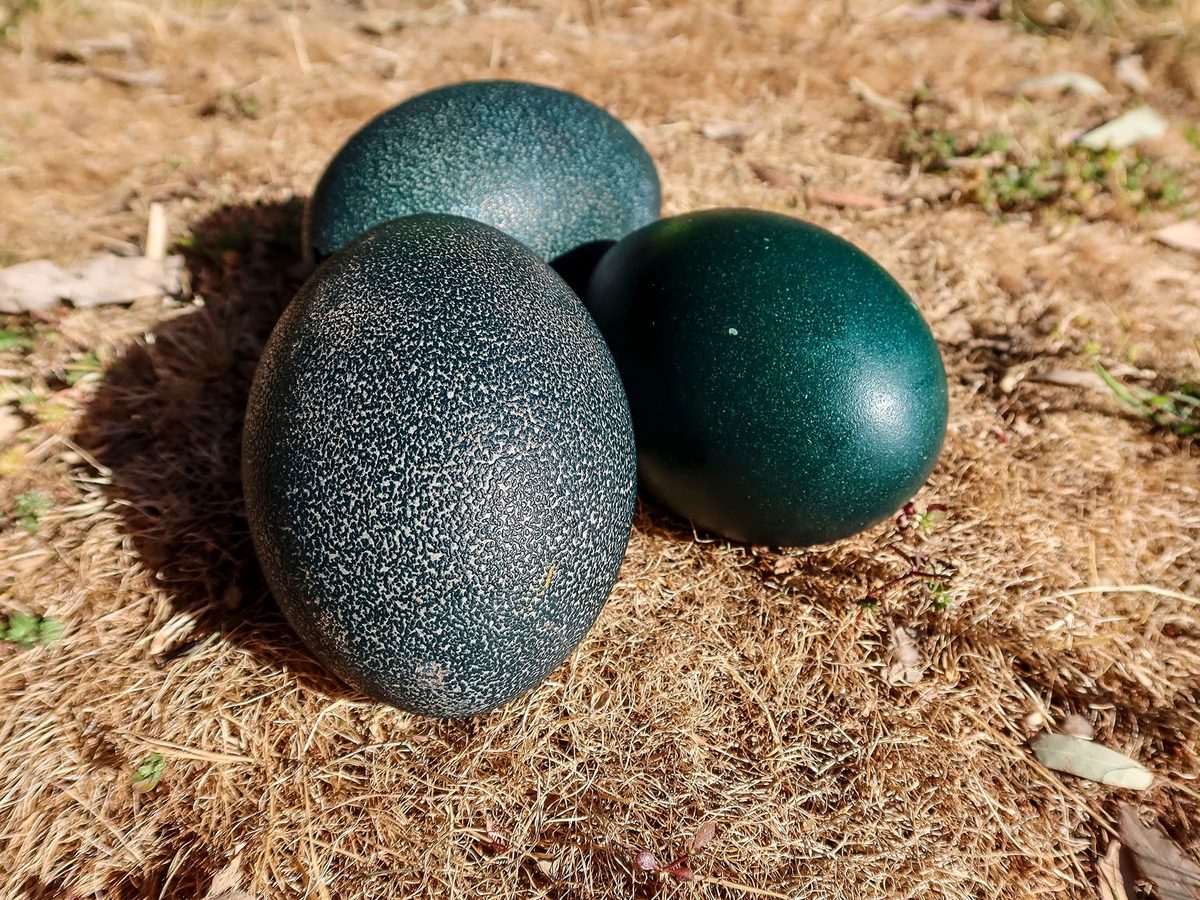Emus are gigantic birds from the flightless ratite group, which includes other massive birds like the cassowary and ostrich. Living solely in Australia, the Emu is intriguing due to its female-dominated social and breeding system.
This is a guide to Emu nesting, including incubation, eggs and nest construction.
Emu nests are rudimental, consisting of a small pile of leaves or grasses, which are sometimes laid in a shallow indent scraped into the ground.
Female Emus are larger than males and mate with multiple partners in the same breeding season. Once the female lays her clutch, the male takes care of incubation duties and looks after the young birds.
Incubation takes an arduous 50 to 60 days, and the male won’t leave the nest to feed, drink or defecate in this time - he can lose up to a third of his own body weight!
Of course, there is much more to learn about this intriguing bird, so read on to find out!

Emu nests are extremely simple, and generally consist of a small pile of leaves of grasses
Nest Location
Do Emus have nests?
Emus do have nests, though they’re built on the floor rather than in trees. The male emu builds a rudimental nest which is sometimes built on the flat and sometimes built in a narrow hollow scraped into the dirt up to 10 cm deep at the most.
The nest area is around 1 to 2m across. Some nests are loosely covered in grass and leaves, especially if it’s cold, but it depends on the region and what’s available. The resulting construction looks like a roughly circular pile of plant debris.
Do Emus nest in the same place every year?
Emus are nomadic and move north and south throughout the year, often tracking rainfall as this signals plant growth and, therefore, food and water.
Emus return to the same breeding grounds most years, but there’s no evidence that they return to the same nesting site each year. Breeding grounds are selected based on food and water availability, as these factors are critical to the survival of chicks.
How high are Emu nests?
Emu nests are sometimes totally flat, especially if it’s relatively warm. They aren’t high at all, and essentially amount to a roughly circular pile of roughly assembled twigs and leaves.
However, if it’s colder than usual, the male may excavate a recess of some 7 to 10cm, as this increases heat retention to keep eggs warm.

Close up of two unhatched Emu eggs inside of the nest
Nest Appearance
What do Emu nests look like?
Emus nests are built on flat ground or loosely scraped into the dirt. They don’t look like much at all and appear as shallow hollows filled with leaves, twigs, and grass.
Some nests are more carefully designed as a circle, or small mound, with the eggs in a central depression, whereas others look like a messy pile of twigs and grasses. Some males put greater effort into their nests than others.
How big are Emu nests?
Emu nests are gigantic at around 1 to 2m wide by up to 10cm deep.
Emus are big birds, and their eggs are massive, measuring some 13cm long. As a result, the nest is also large - big enough for an Emu to squat on comfortably!

Close up of the nest of a Emu in the wild, Australia
Phenology
Where do Emus nest?
Emus are divided into three subspecies inhabiting northern, southeastern, and southwestern Australia.
Each subspecies broadly moves north in the summer and south in the winter. The nest itself is built in an open area with a low level of surrounding foliage to provide shelter and camouflage.
Studies find that most nests are built near some sort of tree or foliage cover rather than in exposed areas.
How long do Emus nest for?
The Emu breeding season lasts from around February to June, which is the Australian winter.
Breeding is broadly timed with cooling temperatures, as this also means higher food and water availability. The breeding season does vary, however, and Emus have been recorded breeding at unpredictable times of the year.
The male incubates the eggs for some 48 to 56 days, but once the chicks hatch, they can walk and leave the nest within 1 to 3 days. So, the nesting period ceases imminently after the eggs hatch.
What month do Emus lay eggs?
Emus begin to form pair bonds around December to January, and the females typically lay eggs between April and June, which is the Australian winter. Some populations of emus lay eggs sooner, as early as November.
One study of Emus in New South Wales, southeastern Australia, says they most commonly lay eggs in May and June.
However, breeding seasons are flexible and depend on environmental conditions like temperature and rainfall - the breeding season may even be totally abandoned if it’s too dry in a particular region.

Breeding pair of Emus in Australia
Nest Construction
How do Emus build their nests?
The male Emu builds the nest by scraping a loose hollow into the dirt. Sometimes, the nest is completely flat with no indentation - especially if it’s warm. Then, he’ll line the nest with some leaves and grasses. That’s about it - Emu nests are straightforward and don’t require much work.
Since the Emu breeding system is female-dominated, the male does all the work and incubates the eggs alone without assistance from the female. The female usually wanders off to re-mate but may linger to defend the rest and accompany the male.
What do Emus use for nesting?
Emu nests use leaves and grasses to cover or line their nests.
Do male or female Emus build the nest?
The Emu breeding and social system is dominated by females, who mate with multiple males and leave them to incubate eggs and raise chicks.
The male Emu builds the nest, the female lays her eggs - sometimes multiple females lay eggs in the same nest - and the male incubates them for around 50 to 56 days.
During this time, he rarely leaves the nest and loses a huge amount of body weight - up to a third in some cases.

Close up of a male Emu incubating the eggs in the nest
Emu Eggs
What do Emu eggs look like?
Emu eggs are massive, measuring around 13 x 9 cm and weighing up to 650g. They’re very ovular with a deep emerald green color and a rough shell.
How many eggs do Emus lay?
Female Emus often lay more than one clutch of between 5 and 20 eggs, but 8 to 10 is around the average. In one breeding season, a female might lay three clutches or as many as 50 eggs in total.
Do male Emus sit on eggs?
Male Emus handle all incubation duties, sitting on the nest for around 48 to 56 days. They don't leave the nest at any point throughout incubation, moving only to drink morning dew off nearby foliage by stretching their long necks.
The male might lose up to a third of his body weight. Meanwhile, the female usually wanders off to mate with another male but might linger around to defend the nest in some situations.

Close up of three Emu eggs
Fledgling and Parental Care
When do baby Emus leave the nest?
Baby Emus are born precocial, meaning they’re highly developed at hatching and are covered in a fluffy down. They can walk within just hours of hatching and will begin to roam around the area surrounding the nest in 1 to 3 days.
The young birds remain reliant on their father for 3 to 4 months before they break away to join a nearby herd.
How many broods do Emus have?
A female Emu might lay 2 to 3 clutches per breeding season. Once she mates with a male and lays her clutch, she’ll usually wander off to mate with another male.
There are exceptions, as some pairs of Emus have been observed as largely monogamous. But generally, females are polyandrous and mate with multiple males in one season. This is necessary to keep Emu numbers sufficiently high to sustain the population.

Male Emus do the majority of the work when it comes to incubation and raising the chicks
Emu Nesting FAQs
Do Emus abandon their nests?
Once the male Emu settles down to his incubation duties, he won’t move for the entire duration of 50 to 60 days. He won’t feed, drink, or defecate and loses around a third of his body weight.
Emus try to build their nests in protected locations away from predators. If the nest is attacked, the male will hiss at the intruders. Emus are fierce adversaries and won’t easily abandon their nest. Any nearby females would also likely join in to defend the nest.
Do Emus nest on the ground?
Emus are flightless birds and spend their entire lives on the ground. They nest on the ground, either on flat land or a shallow hollow scraped into the dirt.
Where do Emus nest at night?
Emus roost on the ground. They are well-camouflaged against the Australian brush.
Do Emus lay eggs or give birth?
Emus, like all birds, lay eggs. The female lays a clutch of eggs which the male incubates alone.
How long is an Emu pregnant for?
Emus, like all birds, don’t get pregnant. Instead, the female produces eggs which are fertilized by a male. She then proceeds to lay the eggs, which are incubated and hatch.
